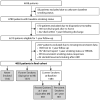Association of Smoking Status With Angina and Health-Related Quality of Life After Acute Myocardial Infarction
- PMID: 26307130
- PMCID: PMC4703446
- DOI: 10.1161/CIRCOUTCOMES.114.001545
Association of Smoking Status With Angina and Health-Related Quality of Life After Acute Myocardial Infarction
Abstract
Background: Smoking cessation after acute myocardial infarction (AMI) decreases the risk of recurrent AMI and mortality by 30% to 50%, but many patients continue to smoke. The association of smoking with angina and health-related quality of life (HRQOL) after AMI is unclear.
Methods and results: Patients in 2 US multicenter AMI registries (n=4003) were assessed for smoking and HRQOL at admission and 1, 6, and 12 months after AMI. Angina and HRQOL were measured with the Seattle Angina Questionnaire and Short Form-12 Physical and Mental Component Scales. At admission, 29% never had smoked, 34% were former smokers (quit before AMI), and 37% were active smokers, of whom 46% quit by 1 year (recent quitters). In hierarchical, multivariable, regression models that adjusted for sociodemographic, clinical and treatment factors, never and former smokers had similar and the best HRQOL in all domains. Recent quitters had intermediate HRQOL levels, with angina and Short Form-12 Mental Component Scale scores similar to never smokers. Persistent smokers had worse HRQOL in all domains compared with never smokers and worse Short Form-12 Mental Component Scale scores than recent quitters.
Conclusions: Smoking after AMI is associated with more angina and worse HRQOL in all domains, whereas smokers who quit after AMI have similar angina levels and mental health as never smokers. These observations may help encourage patients to stop smoking after AMI.
Figures
References
-
- Critchley JA, Capewell S. Mortality risk reduction associated with smoking cessation in patients with coronary heart disease: a systematic review. JAMA. 2003;290:86–97. - PubMed
-
- Wilson K, Gibson N, Willan A, Cook D. Effect of smoking cessation on mortality after myocardial infarction: meta-analysis of cohort studies. Arch Intern Med. 2000;160:939–44. - PubMed
-
- Gerber Y, Rosen LJ, Goldbourt U, Benyamini Y, Drory Y. Smoking status and long-term survival after first acute myocardial infarction a population-based cohort study. J Am Coll Cardiol. 2009;54:2382–7. - PubMed
-
- Rea TD, Heckbert SR, Kaplan RC, Smith NL, Lemaitre RN, Psaty BM. Smoking status and risk for recurrent coronary events after myocardial infarction. Ann Intern Med. 2002;137:494–500. - PubMed
-
- Krumholz HM, Anderson JL, Bachelder BL, Fesmire FM, Fihn SD, Foody JM, Ho PM, Kosiborod MN, Masoudi FA, Nallamothu BK. ACC/AHA 2008 performance measures for adults with ST-elevation and non-ST-elevation myocardial infarction: a report of the American College of Cardiology/American Heart Association Task Force on Performance Measures (Writing Committee to develop performance measures for ST-elevation and non-ST-elevation myocardial infarction): developed in collaboration with the American Academy of Family Physicians and the American College of Emergency Physicians: endorsed by the American Association of Cardiovascular and Pulmonary Rehabilitation, Society for Cardiovascular Angiography and Interventions, and Society of Hospital Medicine. Circulation. 2008;118:2596–648. - PubMed
Publication types
MeSH terms
Grants and funding
LinkOut - more resources
Full Text Sources
Medical
Molecular Biology Databases



